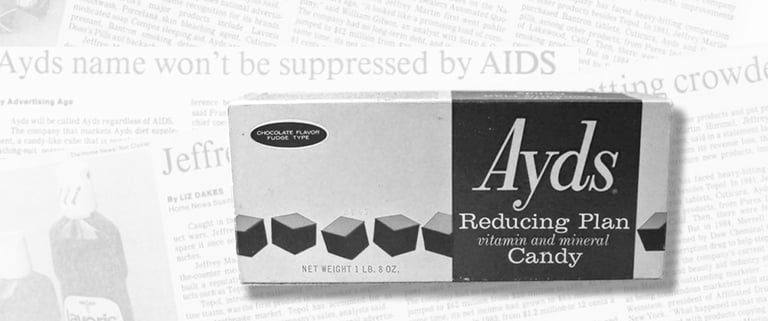How AIDS killed AYDS
AYDS: The Brand That Didn't Survive a Name Crisis and fell from a $150 million height.
How AIDS killed AYDS
You might be part of the majority that haven’t heard about AYDS. And, no, I don’t mean AIDS, even though they sound the same. This is a story of how things went wrong.
The Beginning of AYDS
AYDS was created in the 1930s, and registered by the Carlay Company in the winter of 1946. By the 1970s, it was a household name in the United States.
Their value was simple - they sold candy marketed as an appetite suppressant, and taken before meals. Ever heard of a crazier idea? You see, it contained benzocaine, which made the mouth numb and helped reduce cravings.
The brand's early success was fueled by effective marketing strategies, which focused on the product's uniqueness: it was easy to use and convenient for people on the go.
The Rise of AYDS
At its peak, AYDS was a $150 million business and was one of the most popular weight-loss products on the market. Its success was largely due to its branding and marketing, which emphasized convenience and accessibility. When owned by Dow, led by Irving Willard Crull, they even used socialites and Hollywood celebrities to market AYDS. Influencer marketing is older than this - don’t be shocked.
The product was marketed to busy, health-conscious individuals who didn't have time for traditional diets or exercise routines. The candy's packaging was bright and eye-catching, with bold lettering that made it easy to spot on store shelves. The brand also sponsored fitness and weight-loss programs, further securing its place in the market.
The Fall of AYDS
In 1981, it was sold to Jeffrey Martin Inc. Unfortunately, at the same time, in the 1980s, the AIDS epidemic swept the world, and the name "AYDS" suddenly took on a whole different meaning. The similarity between the product name and the disease was an unfortunate coincidence, but it proved disastrous for the brand. A few branding experts suggested that a name change was imminent but, in 1986, an executive of Jeffrey Martin responded, "The product has been around for 45 years. Let the disease change its name."
Sales of AYDS plummeted, and the company struggled to recover. In the late 1980s, they rebranded to Diet AYDS - stop laughing at them. Despite attempts to rebrand and change the name of the product, the damage had been done. The association between the product and the deadly disease was too strong, and consumers lost trust in the brand. The fact that both the disease and the candy caused weight loss did not help their case either.
Lessons
You don’t own a brand. Your audience does. And their brand perception changes with time. You have to be ready to remedy the situation.
Rebranding must be because of a mismatch in who you are and who the audience feels you are. You don’t rebrand because you are bored with what you are. Nothing more, nothing less.
Final Thoughts, if your audience’s feeling about your product or service is not broken, and nothing will be broken as far as you can see, do not rebrand. Stop it.
Honestly, I’m tired of getting potential clients saying they are rebranding because they are bored with the brand, while their audience is enthusiastic about the brand. We don’t take them on. It won't help their business.


We simplify brand building for those starting, growing, or changing direction.
You will receive all our thinking straight to your email.
